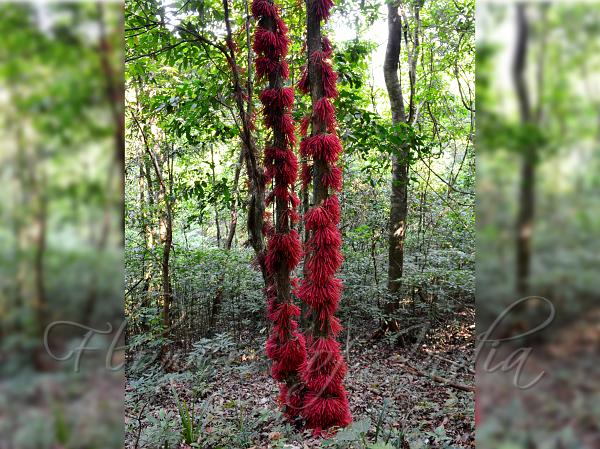|
| Mootapalam |
|

|

| File size | 1187178 |
| Original date | 3/21/15 9:54 AM |
| Resolution | 0 x 0 |
| Flash | Flash did not fire, auto |
| Focal length | 18.0mm |
| Exposure time | 1/15s |
| Aperture | 8.0 |
| Focus Distance | |
| Metering Mode | Multi-segment |
| Camera make | NIKON CORPORATION |
| Camera model | NIKON D5100 |
| Sensor type | OneChipColorArea |
|
|
|
|
Photo: |
Botanical name: Baccaurea courtallensis Family: Phyllanthaceae (Amla family)
Synonyms: Pierardia courtallensis, Baccaurea macrostachya, Pierardia macrostachya
Synonyms: Pierardia courtallensis, Baccaurea macrostachya, Pierardia macrostachya
Mootapalam is an evergreen tree up to 15 m high;
bole uneven with tubercles; bark greyish-yellow, rough; branchlets
round, rough; young shoots brown-puberulous and furfuraceous. Leaves
simple, alternate, often clustered towards the tip of branchlets;
stipules 3-5 mm long, lateral, lanceshaped, falling off; leaf-stalk
10-60 mm long, slender, grooved above, becoming hairless or puberulous;
blade 5.5-30 x 1.5-8.5 cm, inverted-lanceshaped or
elliptic-inverted-lanceshaped, base pointed, narrowed or wedge-shaped,
tip tapering or caudate-tapering, margin entire, membranous to
chartaceous, scattered white furfuraceous above and beneath, often
scattered puberulous on midrib beneath; lateral nerves 4-7 pairs,
pinnate, slender, faint, intercostae netveined, obscure. Flowers are
unisexual, dark crimson, in densely clustered slender racemes on old
stem; male flowers: bracts lanceshaped, linear-lanceshaped or
triangular, free, conduplicate, encircling the base of lateral
branches; tepals 4-5, 1.5-2 x 1 mm, linear, oblong, elliptic, nearly
round or inverted-lanceshaped, hairless or sparsely puberulous; stamens
4-8, free; anthers basifixed; pistillode club-shaped; female flowers:
bracts 1-1.5 mm long, lanceshaped; tepals 4-5, 2.5-3 x 0.6-1.5 mm,
linear, oblong or oblong-elliptic, sparsely puberulous to hairless,
fringed with hairs; ovary superior, 2.5 x 2-3 mm, ovoid or
subspherical, 3-locular, ovules 2 in each cell, 3-angled, woolly;
stigmas 3, flabellate. Fruit a capsule 15-30 x 15-25 mm, subspherical,
ovoid, ellipsoid or obovoid, 3 locular, thick walled, often with 6
longitudinal ribs, pale yellow when ripe, brown when dry, often
verrucose, velvet-hairy, tardily dehiscent; seeds 3, oblong, arillate.
Mootapalam is found in Peninsular India. Flowering: January-April.
| Identification credit: Anurag Sharma | Photographed in Aralam WLS, Kerala. |
• Is this flower misidentified? If yes,